Legit Security Launches VibeGuard to Secure AI-Generated Code at the Moment of Creation
Boston - Nov. 12, 2025 - Legit Security announced VibeGuard, the industry's first solution built to secure AI-generated code the instant it's created and to protect the coding agents producing it. The approach is simple: turn it on, and agents start coding with security in mind.
By plugging directly into AI-integrated IDEs, VibeGuard monitors agent behavior in real time, blocks attacks, and prevents vulnerabilities before they hit production. It continually injects security and application context into your agents so they learn to produce safer output over time.
Why this matters to engineering and security teams
Vibe coding is becoming the default, and code volume now outpaces manual review. In a recent survey by Legit and Gatepoint Research (117 security professionals), 56% cited lack of visibility or control over AI-generated code as their top concern. Traditional AppSec tools rely on human workflows and after-the-fact scanning - a mismatch for machine-generated software.
AI coding agents also add new risks: prompt injection, sensitive data exposure via unpredictable behavior, and unsafe third-party MCPs. For background on common LLM risks, see the OWASP Top 10 for LLM Applications.
What VibeGuard delivers
- Secures AI-generated code at creation: Moves AppSec from reactive testing to proactive protection inside AI dev workflows. Uses instructions, rules, policy-based controls, safeguards against suspect agents, and guardrails so generated code meets security standards.
- Protects and secures AI coding agents: Monitors how agents use models, MCP tools, and sensitive data. Blocks attacks and governs the entire fleet for data security and compliance.
- Gives AppSec complete visibility into AI use: Centralizes insight across prompts, models, MCPs, and environments with the ability to restrict, block, and enforce security policies.
How it integrates with your stack
VibeGuard connects directly to IDEs and agents such as Cursor, Windsurf, and GitHub Copilot. It watches prompts, model choices, MCP usage, and code suggestions continuously. It trains agents on secure practices and applies guardrails to detect and stop risky behavior, including calls to malicious MCP servers or exposure of sensitive files.
Why now
Software creation has shifted from manual, line-by-line work to machine-assisted generation. Attackers exploit prompt injection and tool misuse - issues highlighted by Legit's recent CamoLeak finding. Protection has to evolve alongside creation, which means building security into the exact point where code is generated.
Leaders weigh in
"We're at an inflection point in how software is built," said Roni Fuchs, co-founder and CEO at Legit Security. "Code is no longer written line-by-line by humans - it's generated by machines. With VibeGuard, we're not just launching a new product, we're defining what it means to secure AI-native development. AI is transforming software creation, and for the first time in history, we have a real opportunity to create software that's truly secure - by design."
"AI has completely changed the game for application development. Our engineering teams are writing code and building apps faster than ever - most of the time assisted by AI," said Nir Yizhak, Chief Information Security Officer and Vice President at Firebolt. "We see AI-powered development as a huge opportunity, particularly when it comes to delivering code that is clean and secure from the start. I'm excited to see Legit take this big step forward in delivering capabilities that will help us greatly reduce risk while at the same time ensuring fast code delivery."
Practical next steps for IT, AppSec, and platform teams
- Inventory where AI code generation happens (IDEs, agents, MCPs, models) and define ownership for each environment.
- Set guardrails: secret exposure policies, model allow/deny lists, MCP allow lists, data boundaries, and logging/audit requirements.
- Pilot VibeGuard in one IDE (e.g., Cursor or Windsurf) and one high-risk repo. Track blocked events, policy violations, and mean time to remediate.
- Instrument prompts and agent actions for auditability; feed findings into SDLC gates and CI policies.
- Train developers on prompt hygiene and secure agent usage, backed by policy enforcement rather than manual reviews.
If you need a baseline framework to align policies, review the NIST Secure Software Development Framework (SSDF).
The bottom line
VibeGuard brings AppSec to the source: the moment code is generated and the agents generating it. It bridges speed and security, giving teams the control and visibility they've been missing in AI-native development.
Upskilling your team on AI coding and security? Explore focused resources at AI Certification for Coding and curated AI tools for generative code.
Your membership also unlocks:






